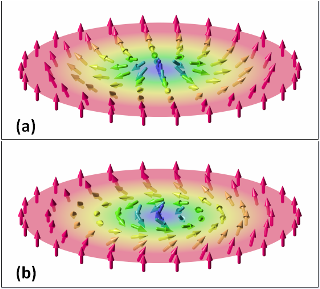Oct 14 2015
A KTH researcher is part of an international team that has unlocked the secret to creating stable dynamic skyrmions – the nanoscale magnetic whirls that promise to meet our insatiable appetite for data storage.
 The vector field of two, two-dimensional magnetic skyrmions. (Image: Karin Everschor-Sitte and Matthias Sitte (The Authors) [CC BY-SA 3.0 (http://creativecommons.org/licenses/by-sa/3.0)], via Wikimedia Commons)
The vector field of two, two-dimensional magnetic skyrmions. (Image: Karin Everschor-Sitte and Matthias Sitte (The Authors) [CC BY-SA 3.0 (http://creativecommons.org/licenses/by-sa/3.0)], via Wikimedia Commons)
The future of data storage is likely to be found in nanometer scale, stable magnetic whirls called skyrmions, which behave like particles in magnetic thin films. But creating these whirls has been notoriously difficult, requiring carefully-engineered multilayers or very specific bulk materials.
However, recent research published in Nature Communication could change that. Johan Åkerman, a renowned spintronics researcher and a guest professor at KTH Royal Institute of Technology who co-led the study, says that the research enables an entirely new range of materials where skyrmions can be observed.
"Since there is an insatiable appetite for storing information, for uses such as mobile phones, computers, and particularly online, nano-skyrmions are very interesting as an information carrier," Åkerman says. "They can be made extremely small and are easily programmed using spin-polarized currents like in MRAM (magnetoresistive random-access memory)."
The team showed that a magnetic skyrmion can be created under a nanocontact, in which a spin-polarized current is injected into the magnetic thin film providing a so-called spin torque to its magnetic moments. For sufficiently large currents, this setup will allow the creation of a skyrmion of 10-20 nanometers in size, underneath the nanocontact.
A skyrmions can also be stabilized by the spinning motion around its own axis, in a way that's similar to how a top stabilizes itself. Once created, they can be transported over distances of several hundreds nanometers, which means that skyrmions can be created and manipulated in materials that have never before been considered for skyrmionics.
In using the spin-polarized currents, the study recalls Åkerman's discovery of a spin torque-generated nano-droplet in 2013.
"We have also shown that the dynamic skyrmions can generate much stronger output in spintronic oscillators, so the potential use for this new phenomenon is great," he says.
The study also involved researchers at University of Gothenburg (Sweden), University of Hong Kong (China), and University College Dublin (Ireland).